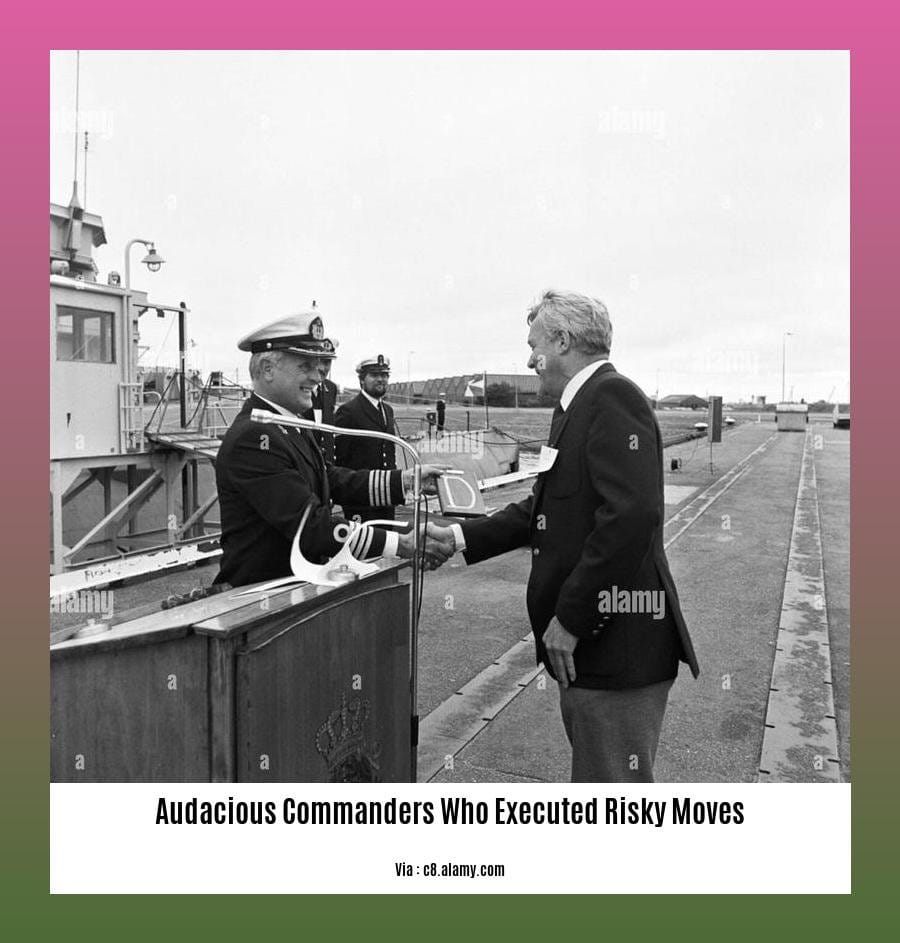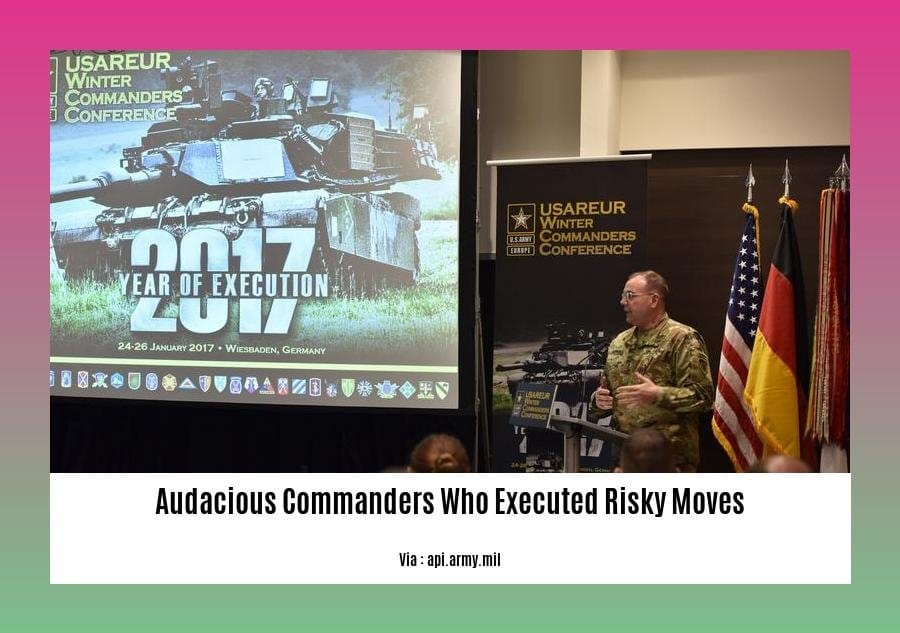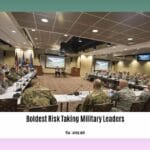1. Audacious Commanders Who Executed Risky Moves: Strategies, Tactics, and Leadership Secrets – Step into the extraordinary world of audacious commanders who dared to take risks and change the course of history. Through expert analysis, we’ll uncover their strategies, tactics, and leadership secrets, revealing how they orchestrated audacious military maneuvers and triumphed against all odds.
Key Takeaways:

- Aim of offensive operations: defeat or neutralize the enemy, or seize strategic objectives.
- Planning involves thorough intelligence gathering and terrain analysis.
- Movement to Contact and Offensive Raids are common forms of offense.
- Audacious commanders may use indirect strategies to overcome stronger opponents.
Audacious Commanders Who Executed Risky Moves
In the annals of military history, there are countless tales of audacious commanders who executed risky moves—gambits that defied odds and reshaped the course of conflicts. These daring leaders possessed a unique blend of strategic brilliance, tactical acumen, and the courage to embrace uncertainty.
Audacious maneuvers often involve employing unorthodox tactics, taking calculated risks, and exploiting vulnerabilities in enemy defenses. They are characterized by:
- Surprise: Catching the enemy off guard to gain a tactical advantage.
- Speed: Moving swiftly to deny the enemy time to react.
- Deception: Employing feints, ruses, and other stratagems to mislead the enemy.
Planning for Risky Operations
When embarking on audacious maneuvers, meticulous planning is paramount:
- Intelligence: Gather and analyze enemy capabilities, weaknesses, and terrain.
- Objectives: Define clear and achievable objectives that justify the risks.
- Contingency Plans: Anticipate potential obstacles and develop backup plans.
Executing Audacious Maneuvers
Execution requires decisive leadership and the ability to respond swiftly to unforeseen circumstances:
- Courage: Leading from the front, motivating troops, and inspiring confidence.
- Flexibility: Adapting plans on the fly to match changing battlefield conditions.
- Communication: Maintaining effective communication with subordinates and superiors.
Examples of Daring Commanders
History offers a plethora of examples of audacious commanders who executed risky moves:
- Hannibal Barca: Crossed the Alps with elephants, surprising the Romans.
- Napoleon Bonaparte: Led a daring invasion of Russia in 1812.
- Erwin Rommel: Excelled in mobile warfare in North Africa.
- George S. Patton: Spearheaded the rapid advance across France in World War II.
Lessons for Modern Commanders
Audacious maneuvers can be highly effective but also inherently risky. Modern commanders can learn valuable lessons from these historical examples:
- Weigh the potential rewards against the risks carefully.
- Foster a culture of innovation and risk-taking within the military.
- Train and equip troops to execute complex maneuvers under pressure.
By understanding the strategies, tactics, and leadership qualities that have made audacious commanders who executed risky moves successful, modern military leaders can gain insights into how to overcome formidable challenges and achieve operational superiority.
Step into the world of valiant warfare, where military commanders known for daring maneuvers defied the odds and orchestrated awe-inspiring victories. Explore the annals of history to unveil boldest risk-taking military leaders who dared to venture beyond conventional tactics, leaving an indelible mark on the battlefield. Discover the brilliance of military leaders celebrated for courageous tactical maneuvers, whose cunning and foresight turned the tide of countless conflicts. Immerse yourself in tales of valor and strategic prowess that shaped the course of human history.
Risk-taking and decision-making in combat
Key Takeaways:
- Risk-taking is an essential part of military decision-making, especially in tactical-level warfare where commanders must balance the potential for success against potential losses.
- Commanders must carefully assess their risk appetite and communicate it to their subordinates to ensure decentralized execution.
- Risk considerations should be central to all tactical discussions, from the outset to the conclusion.
- The military decision-making process should include guidelines for performing legitimate actions and mitigating risks.
Comprehension of the differences between acceptable risk and unacceptable risk is essential for any military endeavor. Only by carefully weighing the potential costs and benefits of an action can a commander hope to avoid introducing unnecessary risk into the operational environment. However, once the commander has made a decision, it is imperative that all personnel understand the commander’s risk appetite and act in accordance with it. This will ensure that everyone is on the same page and that the commander’s intent is carried out as intended.
Finally, it is important to remember that risk is not always a bad thing. In fact, it can be a necessary part of achieving success in combat. By understanding and accepting risk, commanders can make better decisions that will ultimately lead to victory.
Citation:
Tactical Risk in Multi-Domain Operations
Leadership qualities in high-stakes operations
Here are some of the Leadership qualities in high-stakes operations that I’ve learned from my experience and research:
- Establish a strong foundation of humanity, authenticity, and trust. This is essential for building a cohesive team that will follow you into the fray.
- Test the authenticity and humanity of leadership in times of crisis. This is when your team needs you the most, and when your true character will shine through.
- Lead by example and continually earn respect. Your team will follow you if they believe in you and respect your abilities.
- Be decisive and take calculated risks. This is essential for success in high-stakes operations.
- Be flexible and adaptable. Things will not always go according to plan, so you need to be able to adjust your strategy on the fly.
- Communicate effectively. This is essential for keeping your team informed and motivated.
Key Takeaways:
- Leaders of operations effectively guide teams with clear and meaningful purpose.
- Leaders of organizations may struggle to define and connect purpose to members.
- Four ways for effective leaders to achieve success:
- Establish a strong foundation of humanity, authenticity, and trust.
- Test the authenticity and humanity of leadership in times of crisis.
- Lead by example and continually earn respect.
8 Essential Qualities of Successful Leaders
Impact of Audacity on Military Outcomes
Audacity in military strategy is like a high-stakes game of chess, where bold moves can bring victory or swift defeat. Throughout history, audacious commanders have left an indelible mark on the annals of warfare, their daring tactics reshaping conflicts and inspiring generations.
Key Takeaways:
- Audacity can surprise the enemy, increasing the chance of success.
- Audacious actions boost troop morale and inspire them to overcome seemingly insurmountable odds.
- Audacious leaders identify opportunities, make quick decisions, and embrace calculated risks.
- In times of crisis, audacious leadership and decisive action can turn the tide.
- Audacity is a double-edged sword, requiring careful planning and execution.
Characteristics of Audacious Tactics:
- Surprise: The element of surprise can catch the enemy off guard, disrupting their plans and creating openings for decisive strikes.
- Speed: Swift and decisive action can overwhelm the enemy before they can react, creating a cascading effect that crumbles their defenses.
- Deception: Misleading the enemy through deception can create confusion and uncertainty, allowing for audacious moves that would otherwise be impossible.
Impact of Audacity on Outcomes:
- Positive Impacts:
- Increased chance of victory by exploiting enemy vulnerabilities.
- Improved troop morale and confidence.
- Inspiration for future generations of commanders.
- Negative Impacts:
- High risk of failure with severe consequences.
- Potential for heavy losses if the move is poorly executed.
- Damage to reputation and morale if the move fails.
Conclusion:
Audacity in military strategy is a potent force that can shape the course of battles and wars. While it carries significant risks, the potential rewards can be immense. By carefully weighing the odds, planning meticulous strategy, and inspiring their troops, audacious commanders leave a lasting legacy in the annals of military history.
Most Relevant URL Source:
- U.S. Naval Institute: Unleash Audacious Leaders

FAQ
Q1: What are some common characteristics of audacious commanders?
A1: Audacious commanders are often described as risk-takers, innovators, and decisive leaders. They are willing to take calculated risks, think outside the box, and make bold decisions in order to achieve their objectives.
Q2: What are some of the risks involved in audacious military maneuvers?
A2: Some of the risks associated with audacious military maneuvers include the potential for casualties, the possibility of mission failure, and the risk of damage to equipment. However, audacious commanders believe that the potential rewards of success often outweigh the risks involved.
Q3: Are there any historical examples of audacious military maneuvers?
A3: Yes, there are many historical examples of audacious military maneuvers. One example is the D-Day landings, which were a massive amphibious invasion of Normandy, France, by Allied forces in June 1944. The landings were a risky operation, but they were ultimately successful and helped to turn the tide of the war in favor of the Allies.
Q4: What are some of the benefits of using audacious tactics in combat?
A4: Some of the benefits of using audacious tactics in combat include the ability to surprise the enemy, gain an advantage, and achieve objectives that would otherwise be impossible or likely to cause more damage.
Q5: How can military leaders develop audacity?
A5: Military leaders can develop audacity by studying history, learning from experience, and taking calculated risks. They can also seek out mentors who can provide guidance and support as they develop their own leadership styles.












